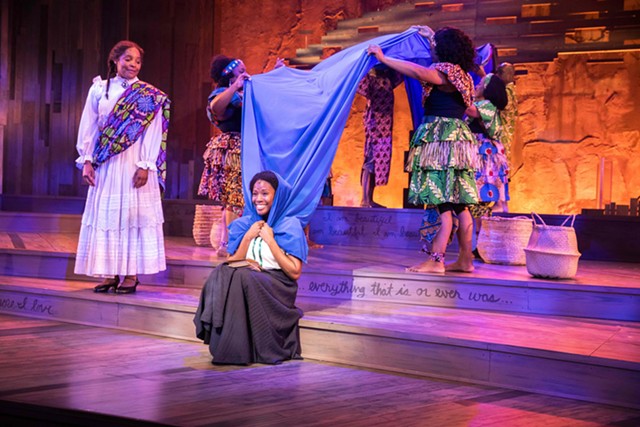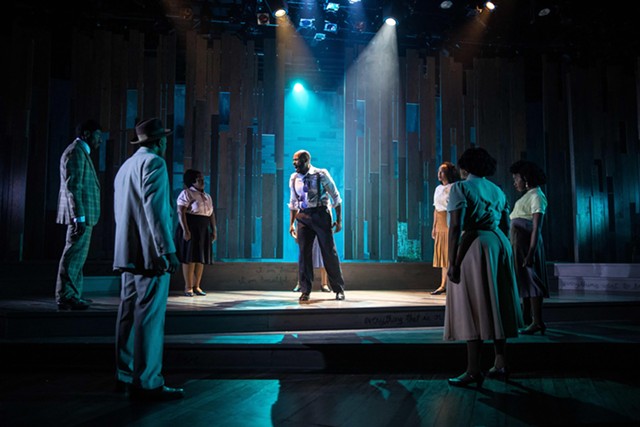In 1983, “The Color Purple” made Alice Walker the first Black woman to win a Pulitzer Prize for Fiction—and certainly the first to win for a novel centered on a queer Black protagonist. Through June 29, Geva Theatre Center — in partnership with Theater Latté Da in Minneapolis — stages the 2005 musical adaptation in an exuberant and sensual production.
Set in Georgia during the first half of the 20th century, “The Color Purple” opens with a young girl named Celie (Nubia Monks), pregnant for the second time by her stepfather, who takes both babies away from her. It’s a grim start, though the musical glosses over the details, inviting audiences with a rousing church number and focusing on Celie’s friendship with her sister Nettie (the wholesome, sweet Nami Mwassa). A local widow referred to as Mister (a stern David L. Murray Jr.) sets his eye on marrying Nettie. To make sure Nettie can continue her education, Celie agrees to marry Mister and becomes abused by her husband rather than by her stepfather.
When Mister’s son, Harpo (the charismatic, baby-faced Ronnie Allen) opens a juke joint, it attracts Mister’s former love, a traveling singer Shug Avery (the commanding Angela Wildflower). With Shug in town, Celie falls in love for the first time and finds the confidence to recognize her own self-worth.
While the show acknowledges multiple traumas — the main characters are only a generation removed from slavery, as Mister’s father points out when explaining why owning the land he was born enslaved on means more to him than his son’s wishes —the tone of Marsha Norman’s book is ultimately upbeat and hopeful. The music (written by songwriters Brenda Russell, Allee Willis, and Stephen Bray) is a pleasant mix of gospel and silky Broadway ballads with infusions of African rhythms, bebop, and blues. Heather Himes’s choreography further energizes the show with swinging hips and rhythmic movement.
 The set, designed by Eli Sherlock, consists of an impressive large display of wooden panels, with some missing pieces, the gaps revealing the ever changing colors of the backdrop – royal blues and deep purples and vibrant oranges. In front are gray steps with fragments of Celie’s prayers scrawled on the sides: “I believe God is everything” and “everything want to be loved.” In the second act, the wooden wall opens to reveal a tree made of panels to indicate one character’s missionary trip to Africa.
The set, designed by Eli Sherlock, consists of an impressive large display of wooden panels, with some missing pieces, the gaps revealing the ever changing colors of the backdrop – royal blues and deep purples and vibrant oranges. In front are gray steps with fragments of Celie’s prayers scrawled on the sides: “I believe God is everything” and “everything want to be loved.” In the second act, the wooden wall opens to reveal a tree made of panels to indicate one character’s missionary trip to Africa.
Simple set pieces, like the string of lanterns to indicate Harpo’s juke joint or a rocking chair for Celie’s home help evoke a variety of locations. The real magic, though, comes from the lighting (designed by Bentley Heydt and Jason Lynch), a richly atmospheric blend of colors that distinguish the locations while heightening the mood of each scene. The opening church scene is lit in the ephemeral glow of the heavens opening, while Celie’s sexual awakening happens in sultry fractured shadows. The main women get introduced in warm colors while the dangerous men are underscored with red. It’s a kaleidoscopic feast for the eyes, always in service of the storytelling.
Director Daniel J. Bryant is mostly tight in his command of the show, showing a strong grasp of the musical comedy form, although fumbles in communicating the passage of time. Celie and Nettie are too cartoonish when playing teenagers, with Celie angrily stomping her foot when forced into marriage as though she’s a toddler deprived a lollipop rather than a traumatized adolescent losing any chance of independence. The final scene jumps an unclear amount of time in the future — based on the dialogue, at most only a couple years have passed, yet Celie looks decades older with suddenly gray hair.
 This confusion is a quibble compared to the powerhouse performances of the cast. Even bit roles are a delight, like the trio of judgmental church ladies (Heather McElrath, Angela Stewart, and Lynnea Doublette). The show has complicated, challenging roles for black actresses, and the leads don’t disappoint. Carnetha Anthony as Sofia, Harpo’s wife, is a force to be reckoned with as she refuses to be mistreated in the rousing “Hell No.” Shug Avery has an entire song hyping her up (“Shug Avery Comin’ To Town”), and Wildflower lives up to anticipation, warming into the role like a spark that ignites into a flame with her crowd pleasing solo at the juke joint, “Press da Button.”
This confusion is a quibble compared to the powerhouse performances of the cast. Even bit roles are a delight, like the trio of judgmental church ladies (Heather McElrath, Angela Stewart, and Lynnea Doublette). The show has complicated, challenging roles for black actresses, and the leads don’t disappoint. Carnetha Anthony as Sofia, Harpo’s wife, is a force to be reckoned with as she refuses to be mistreated in the rousing “Hell No.” Shug Avery has an entire song hyping her up (“Shug Avery Comin’ To Town”), and Wildflower lives up to anticipation, warming into the role like a spark that ignites into a flame with her crowd pleasing solo at the juke joint, “Press da Button.”
The role of Celie is both vocally and emotionally taxing, and has been taken on by divas including Fantasia Barrino and Cynthia Erivo. Here, Nubia Monks holds her own amongst these big names. She sings with a tender rawness that captures Celie’s big emotions, from pain to longing. Both her impressive lung capacity and ability to convey emotional strength through song are showcased in the 11 o’clock number “I’m Here,” which stopped the show during the opening night performance, garnering applause mid-song along with a well-earned standing ovation at its conclusion.
The show opts for breadth over depth in covering Celie’s life, particularly when developing the role of religion and Celie’s queerness. That said, the novelty of watching a heroine care more for her sister than her husband and hearing two black women sing a love song (“What About Love?”) in a major musical is thrilling in its own right. It’s strange to call a musical that includes rape, abuse, and failed romance “feel good,” but “The Color Purple” lifts spirits like a well-told sermon.
“The Color Purple” continues at Geva Theatre Center through June 29. More info and tickets here.
Katherine Varga is a contributor to CITY.
Set in Georgia during the first half of the 20th century, “The Color Purple” opens with a young girl named Celie (Nubia Monks), pregnant for the second time by her stepfather, who takes both babies away from her. It’s a grim start, though the musical glosses over the details, inviting audiences with a rousing church number and focusing on Celie’s friendship with her sister Nettie (the wholesome, sweet Nami Mwassa). A local widow referred to as Mister (a stern David L. Murray Jr.) sets his eye on marrying Nettie. To make sure Nettie can continue her education, Celie agrees to marry Mister and becomes abused by her husband rather than by her stepfather.
When Mister’s son, Harpo (the charismatic, baby-faced Ronnie Allen) opens a juke joint, it attracts Mister’s former love, a traveling singer Shug Avery (the commanding Angela Wildflower). With Shug in town, Celie falls in love for the first time and finds the confidence to recognize her own self-worth.
While the show acknowledges multiple traumas — the main characters are only a generation removed from slavery, as Mister’s father points out when explaining why owning the land he was born enslaved on means more to him than his son’s wishes —the tone of Marsha Norman’s book is ultimately upbeat and hopeful. The music (written by songwriters Brenda Russell, Allee Willis, and Stephen Bray) is a pleasant mix of gospel and silky Broadway ballads with infusions of African rhythms, bebop, and blues. Heather Himes’s choreography further energizes the show with swinging hips and rhythmic movement.

- DAN NORMAN.
- From left, Nambi Mwassa, Angela Stewart, Heather McElrath, Lynnea Doublette, France Roberts.
Simple set pieces, like the string of lanterns to indicate Harpo’s juke joint or a rocking chair for Celie’s home help evoke a variety of locations. The real magic, though, comes from the lighting (designed by Bentley Heydt and Jason Lynch), a richly atmospheric blend of colors that distinguish the locations while heightening the mood of each scene. The opening church scene is lit in the ephemeral glow of the heavens opening, while Celie’s sexual awakening happens in sultry fractured shadows. The main women get introduced in warm colors while the dangerous men are underscored with red. It’s a kaleidoscopic feast for the eyes, always in service of the storytelling.
Director Daniel J. Bryant is mostly tight in his command of the show, showing a strong grasp of the musical comedy form, although fumbles in communicating the passage of time. Celie and Nettie are too cartoonish when playing teenagers, with Celie angrily stomping her foot when forced into marriage as though she’s a toddler deprived a lollipop rather than a traumatized adolescent losing any chance of independence. The final scene jumps an unclear amount of time in the future — based on the dialogue, at most only a couple years have passed, yet Celie looks decades older with suddenly gray hair.

- DAN NORMAN.
- From left, Lamar Jefferson, Dennis Spears, Angela Stewart, David L. Murray (Center), Heather McElrath, Carnetha Anthony, Zola Dee.
The role of Celie is both vocally and emotionally taxing, and has been taken on by divas including Fantasia Barrino and Cynthia Erivo. Here, Nubia Monks holds her own amongst these big names. She sings with a tender rawness that captures Celie’s big emotions, from pain to longing. Both her impressive lung capacity and ability to convey emotional strength through song are showcased in the 11 o’clock number “I’m Here,” which stopped the show during the opening night performance, garnering applause mid-song along with a well-earned standing ovation at its conclusion.
The show opts for breadth over depth in covering Celie’s life, particularly when developing the role of religion and Celie’s queerness. That said, the novelty of watching a heroine care more for her sister than her husband and hearing two black women sing a love song (“What About Love?”) in a major musical is thrilling in its own right. It’s strange to call a musical that includes rape, abuse, and failed romance “feel good,” but “The Color Purple” lifts spirits like a well-told sermon.
“The Color Purple” continues at Geva Theatre Center through June 29. More info and tickets here.
Katherine Varga is a contributor to CITY.

